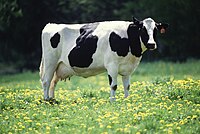
Photo from wikipedia
This work aimed to review the important aspects of the dairy industry evolution at herd level, interrelating production with health management systems. Since the beginning of the industrialization of the… Click to show full abstract
This work aimed to review the important aspects of the dairy industry evolution at herd level, interrelating production with health management systems. Since the beginning of the industrialization of the dairy cattle sector (1950s), driven by the need to feed the rapidly growing urban areas, this industry has experienced several improvements, evolving in management and technology. These changes have been felt above all in the terms of milking, rearing, nutrition, reproductive management, and design of facilities. Shortage of labor, emphasis on increasing farm efficiency, and quality of life of the farmers were the driving factors for these changes. To achieve it, in many areas of the world, pasture production has been abandoned, moving to indoor production, which allows for greater nutritional and reproductive control of the animals. To keep pace with this paradigm in milk production, animal health management has also been improved. Prevention and biosecurity have become essential to control and prevent pathologies that cause great economic losses. As such, veterinary herd health management programs were created, allowing the management of health of the herd as a whole, through the common work of veterinarians and farmers. These programs address the farms holistically, from breeding to nutrition, from prevention to consultancy. In addition, farmers are now faced with a consumer more concerned on animal production, valuing certified products that respect animal health and welfare, as well as environmental sustainability.
Journal Title: Veterinary Sciences
Year Published: 2022
Link to full text (if available)
Share on Social Media: Sign Up to like & get
recommendations!